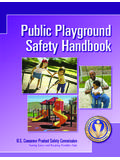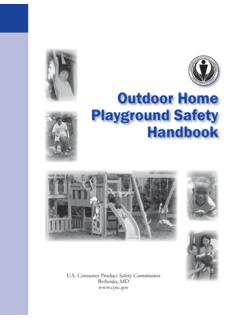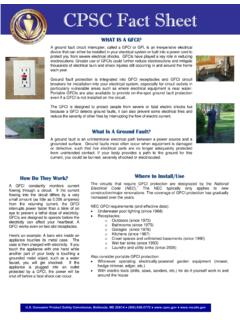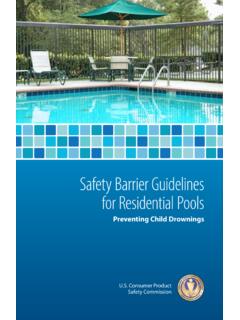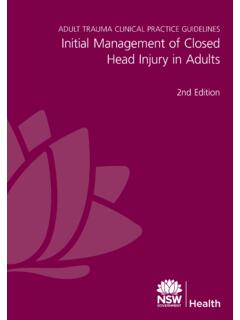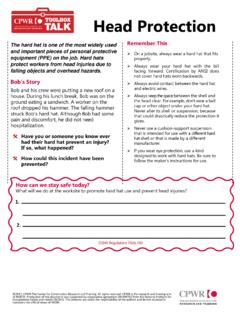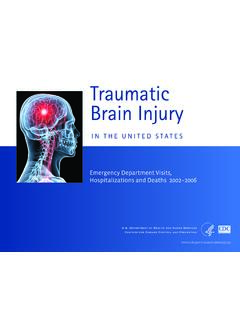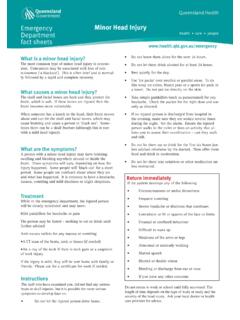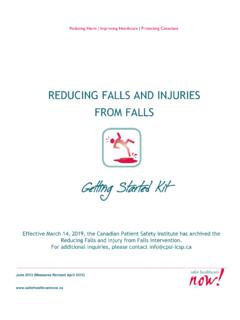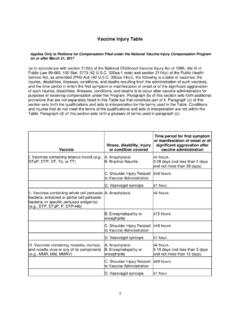Transcription of Consumer Product -Related Injuries and Deaths Among …
1 Consumer Product -Related Injuries and Deaths Among Adults 65 Years of Age and Older This report is intended to provide a general overview, using data taken directly from CPSC files to compare products. The reported Injuries and fatalities were associated with, but not necessarily caused by, Consumer products. The views expressed in this report are those of CPSC staff, and this report has not been reviewed or approved by, and may not reflect the views of, the Commissioners. December 2021. Risana Chowdhury, Blake Smith, Ted Yang, David Miller, John Topping, Angie Qin, Adam Suchy, Matthew Hnatov Division of Hazard Analysis Directorate for Epidemiology Consumer Product Safety Commission 1.
2 THIS DOCUMENT HAS NOT BEEN REVIEWED CLEARED FOR PUBLIC RELEASE. OR ACCEPTED BY THE COMMISSION UNDER CPSA 6(b)(1). Contents Executive Summary ..4. Background ..7. Methods ..9. Table 1 Census Estimates of the 65 and Older Resident Population 2016 Consumer Product -Related Estimated Injuries Among Older Adults 2016 2020 ..11. I. Fall 12. Floors .. 12. Stairs/Steps .. 14. Beds .. 16. Other Fall Injuries .. 18. II. Struck-By/Struck-Against Injuries .. 22. Doors/Windows .. 22. Exercise and Equipment.. 24. Cans/Containers .. 26. Tip Overs .. 29. III. Cut/Pierce Injuries .. 32. Cutleries .. 32. 34. Other Lawn Equipment.
3 36. IV. Other Transportation Injuries .. 38. 38. Golf Carts .. 40. Other Vehicles ..42. V. Other Causes .. 45. 45. Consumer Product -Related Fatalities Among Older Adults 2016 2018 ..48. I. Reported Fall Deaths .. 48. II. Fire Death Estimates .. 52. III. Reported Drowning Deaths .. 54. IV. Reported Other Transportation 57. Bicycle Deaths .. 57. 2. THIS DOCUMENT HAS NOT BEEN REVIEWED CLEARED FOR PUBLIC RELEASE. OR ACCEPTED BY THE COMMISSION UNDER CPSA 6(b)(1). Off-Highway Vehicle (OHV) Deaths .. 59. V. Poisoning Deaths .. 63. Carbon Monoxide (CO) Death Estimates .. 63. Reported Poisoning Deaths Household Cleaners/Laundry Pods.
4 66. VI. Other Causes of Reported Deaths .. 66. Appendix ..67. 3. THIS DOCUMENT HAS NOT BEEN REVIEWED CLEARED FOR PUBLIC RELEASE. OR ACCEPTED BY THE COMMISSION UNDER CPSA 6(b)(1). Executive Summary In this report, Consumer Product Safety Commission (CPSC or Commission) staff of the Division of Hazard Analysis in the Directorate for Epidemiology presents statistics on Injuries and Deaths associated with Consumer products Among adults 65 years and older. Although coverage of all hazard areas is not feasible, we provide statistics for those areas that pose the highest risk for older adults and also involve Consumer Product (s) under CPSC's jurisdiction.
5 Emergency Department-Treated Injuries : From 2016 2020, the latest 5 years of data available from emergency department- treated Injuries , adults 65 and older sustained an estimated million emergency department (ED) treated (an annual average of more than million) Injuries , associated with, but not necessarily caused by, Consumer products. Although there is a statistically significant drop in the estimated ED-treated Injuries from 2019 to 2020, staff observed no statistically significant linear trend over the 2016 through 2020. period. The estimated rate of emergency department-treated Injuries sustained by the older adult population (more than 5 Consumer Product -Related Injuries per 100 older adults in the population) is higher than the rate for adults 25 to 64 (3 Injuries per 100 adults aged 25 to 64) and more frequently leads to hospitalization (nearly 28 percent of Injuries for older adults, versus 8 percent for adults 25 to 64 during 2016 2020).
6 Nearly two-thirds of the estimated Consumer Product -Related Injuries to older adults were due to falls, by far the most common hazard to them. From 2016 through 2020, emergency departments treated nearly million (an annual average of million). estimated Injuries sustained by older adults associated with floors, stairs/steps, and beds. o For fall Injuries sustained on or associated with floors, stairs/steps, and beds that were treated in emergency departments, the top two diagnoses (at around 27% and 21%, respectively) were fractures and internal organ Injuries . o For fall Injuries associated with floors, stairs/steps, and beds, the most frequently injured body part was the head (around 29%), followed by lower trunk (around 18%).
7 The other major Consumer Product -Related hazards facing adults 65 and older are being struck-by/struck-against objects, receiving cut/pierce Injuries , and Injuries from accidents related to the other transportation category in the CDC WISQARS data, shown in Table A of the Appendix. The other transportation category includes 4. THIS DOCUMENT HAS NOT BEEN REVIEWED CLEARED FOR PUBLIC RELEASE. OR ACCEPTED BY THE COMMISSION UNDER CPSA 6(b)(1). mobility products, such as bicycles, golf carts, and off-highway vehicles, Among others. For the struck-by/struck-against category of Injuries associated with Consumer products, doors/windows, exercise equipment, and cans/containers together account for nearly million estimated Injuries (an annual average of 213,300 estimated Injuries ) Among older consumers during the 5-year period.
8 For cut/pierce Injuries associated with Consumer products, cutlery, saws, and lawn equipment together account for about 482,900 estimated Injuries (an annual average of 96,600 estimated Injuries ) to older adults during the 5-year period. Accidents in the category of other transportation involve mobility -Related products. For older adults, the use of some vehicles under CPSC jurisdiction, such as bicycles, off-highway vehicles, golf carts, and micromobility products, account for a combined injury estimate of 258,500 during 2016 2020 (an annual average of 51,700 Injuries ). Bicycles alone account for 80 percent of these estimated Injuries .
9 Other than the above-mentioned specific Consumer products associated with the major hazards to older adults, many more Product categories exist that are associated with a high number of estimated Injuries sustained by adults 65 and over. For example, in 2018 (the mid-point in the 5-year timeframe) the NEISS Data Highlights report 1. shows that annually, more than a dozen other Product groups were associated with 10,000 to 20,000 ED-treated estimated Injuries Among adults 65 and older. Another dozen or so Product groups were associated with 5,000 to 10,000 ED-estimated Injuries annually. There are many Product groups where the estimated rate of emergency department- treated Injuries is higher for the 65 and over group, than people aged 25 to 64.
10 For example, for recliner chairs, during 2016 2020, there were ED-treated Injuries to adults 65 and over per 100,000 in the population versus ED-treated Injuries per 100,000 adults aged 25 to 64. It is expected that the drastic lifestyle changes brought on by COVID-19 has affected the 2020 ED-treated injury estimates to some extent, perhaps some Product areas more than others. Some of these changes are reflected in the NEISS COVID-19 report. 2. 1. AtWr. 2. March%E2%80%93 December-2020. 5. THIS DOCUMENT HAS NOT BEEN REVIEWED CLEARED FOR PUBLIC RELEASE. OR ACCEPTED BY THE COMMISSION UNDER CPSA 6(b)(1).
